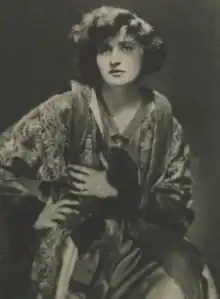Frances Carson
Frances Carson (April 1, 1895 – October 20, 1973) was an American actress on stage and in films, including three Alfred Hitchcock films.
Frances Carson | |
|---|---|
 Frances Carson, from a 1921 publication, photographed by Edward Thayer Monroe | |
| Born | April 1, 1895 Philadelphia, Pennsylvania |
| Died | October 20, 1973 (aged 78) Los Angeles, California |
| Other names | Frances Blind |
| Occupation | Actress |
Early life
Carson was from Philadelphia, Pennsylvania, and started acting and modeling professionally in her teens.[1][2]
Career
Carson was an actress known for stage work in New York and London, and for film roles.[3][4] She performed on Broadway in shows including Poor Little Thing (1914) with her husband Eric Blind, The White Feather (1915), The Riddle: Woman (1918-1919), The Hottentot (1920),[5] The Bad Man (1920),[6][7] The Scarlet Man (1921), The Blue Lagoon (1921),[8] Two Married Men (1925), Potiphar's Wife (1928), The First Law (1929), Slightly Scandalous (1944), and The Visitor (1944).
In London, Carson appeared in Glamour (1922), The Love Habit (1923), R.U.R. (1923, with Basil Rathbone)[9] The Last Warning (1923), Havoc (1924), The Happy Hangman (1925), The Silver Fox (1925), Virginia's Husband (1926), Aloma: A Tale of the South Seas (1926–1927), These Internationals (1928), and The Barker (1928).[10][11] When she played Salome in Leonid Andreyev's Katerina in 1926, with John Gielgud, her revealing costume prompted a censor to insist that she wear a shawl on stage.[12] She also co-wrote a play, The Unknown Woman; it was produced in London in 1927.[13]
Her costumes were photographed and described in fashion columns.[2][14] Critic Giles P. Cain noted in 1917 that "Miss Carson has some decided marks of individuality of speech and manner that bespeak her realization of the fact that merely being natural on the stage is no sign of any very great merit."[15] Noël Coward mentioned seeing Carson dining with Irving Berlin and Elsie Janis at the Algonquin Hotel.[16] British Pathé made a short newsreel about Carson having her fingernails painted by artist Arthur Ferrier in 1924.[17] Also in 1924, she attended a séance with P. G. Wodehouse, Hannen Swaffer, and Donald Calthrop, and believed that she was contacted by her late husband on this occasion.[18]
Carson had roles in several films, including Java Head (1934), Foreign Correspondent (1940), Smilin' Through (1941), Two-Faced Woman (1941),[19] Saboteur (1942),[20] Framing Father (1942), Scattergood Rides High (1942),[21] and Shadow of a Doubt (1943).
Personal life
Carson married British actor Eric Blind in 1913;[22][23] he died suddenly from pneumonia in 1916.[18] She was living with fellow actress Blanche Yurka in Los Angeles in 1940,[24] and died in 1973, aged 78 years.
References
- "New Ingenue is Coming". San Francisco Call. November 6, 1913. p. 8. Retrieved April 11, 2022 – via California Digital Newspaper Collection.
- "This Dainty Foot Marks Real Time". Los Angeles Herald. August 13, 1912. p. 3. Retrieved April 11, 2022 – via California Digital Newspaper Collection.
- "Actress Gives Talk at Century Club Meeting". The Times-Tribune. 1945-12-04. p. 20. Retrieved 2022-04-11 – via Newspapers.com.
- "Actress to Speak Before Women's Club". The News Journal. 1945-11-10. p. 5. Retrieved 2022-04-11 – via Newspapers.com.
- Bordman, Gerald (1995). American Theatre: A Chronicle of Comedy and Drama 1914-1930. OUP USA. p. 124. ISBN 978-0-19-509078-9.
- "The Bad Man". Theatre Magazine. 32: 278. November 1920.
- "Frances Carson". Theatre Magazine. 35: 225. 1922.
- "Actresses in Latest Theatrical Openings". Midweek Pictorial. 14: 9. September 22, 1921 – via Internet Archive.
- The Mander and Mitchenson Theatre Collection presents John Gielgud's notes from the gods : playgoing in the twenties. Internet Archive. London : Nick Hern Books. 1994. pp. 49–51. ISBN 978-1-85459-105-0.
{{cite book}}: CS1 maint: others (link) - Wearing, J. P. (2014-03-27). The London Stage 1920-1929: A Calendar of Productions, Performers, and Personnel. Rowman & Littlefield. ISBN 978-0-8108-9302-3.
- "And England Claims Them All". Vanity Fair. Vol. 27. January 1927. p. 51.
- Times, Wireless To the New York (1926-04-15). "British Censor Tells Salome to Wear More; Frances Carson in 'Katerina' Says Only One Woman Protested and She Stayed". The New York Times. ISSN 0362-4331. Retrieved 2022-04-11.
- "Dramatis Personae". The Observer. 1927-06-26. p. 16. Retrieved 2022-04-11 – via Newspapers.com.
- "Fashion Reflections on the New York Stage". The Spur. 27: 54. May 1, 1921.
- Cain, Giles P. (February 24, 1917). "Little Stories of Plays and Players". The Independent. 37: 3.
- Coward, Noel (1922). Terribly intimate portraits. The Library of Congress. New York, Boni and Liveright. pp. 24–25.
- "Eve's Latest Novelty". British Pathé. 13 March 1924. Retrieved 2022-04-11.
- Bradley, Herbert Dennis (1925). The wisdom of the gods. London: T. Werner Laurie. pp. 68–71.
- The Women's University Club (January 1942). Motion Picture Reviews. Media History Digital Library. Los Angeles, The Women's University Club. p. 9.
- The Women's University Club (May 1942). Motion Picture Reviews (1942). Media History Digital Library. Los Angeles, The Women's University Club. p. 6.
- The Women's University Club (April 1942). Motion Picture Reviews (1942). Media History Digital Library. Los Angeles, The Women's University Club. p. 9.
- The Players. New York: The Players Club. 1917. p. 96.
- "Actor and Actress Enact Wedding Part". The San Francisco Call. 1913-09-09. p. 15. Retrieved 2022-04-11 – via Newspapers.com.
- Nissen, Axel (2016-08-01). Accustomed to Her Face: Thirty-Five Character Actresses of Golden Age Hollywood. McFarland. pp. 218–219. ISBN 978-1-4766-2606-2.
External links
- A 1920 photograph of Carson, in the collection of the National Museum of American History, Smithsonian Institution
- Frances Carson at the Internet Broadway Database
- Frances Carson at IMDb